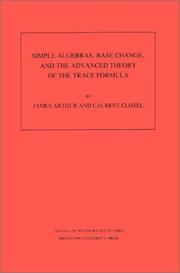| Listing 1 - 3 of 3 |
Sort by
|

ISBN: 0691081794 0691081840 1400881560 9780691081793 Year: 1976 Volume: no. 87 Publisher: Princeton: Princeton university press,
Abstract | Keywords | Export | Availability | Bookmark
 Loading...
Loading...Choose an application
- Reference Manager
- EndNote
- RefWorks (Direct export to RefWorks)
The application by Fadeev and Pavlov of the Lax-Phillips scattering theory to the automorphic wave equation led Professors Lax and Phillips to reexamine this development within the framework of their theory. This volume sets forth the results of that work in the form of new or more straightforward treatments of the spectral theory of the Laplace-Beltrami operator over fundamental domains of finite area; the meromorphic character over the whole complex plane of the Eisenstein series; and the Selberg trace formula.CONTENTS: 1. Introduction. 2. An abstract scattering theory. 3. A modified theory for second order equations with an indefinite energy form. 4. The Laplace-Beltrami operator for the modular group. 5. The automorphic wave equation. 6. Incoming and outgoing subspaces for the automorphic wave equations. 7. The scattering matrix for the automorphic wave equation. 8. The general case. 9. The Selberg trace formula.
Harmonic analysis. Fourier analysis --- Automorphic functions --- Scattering (Mathematics) --- Fonctions automorphes --- Dispersion (Mathématiques) --- Automorphic functions. --- Scattering (Mathematics). --- Dispersion (Mathématiques) --- Selberg, Formule de trace de --- Selberg trace formula --- Eisenstein series --- Eisenstein, Séries d' --- Scattering theory (Mathematics) --- Boundary value problems --- Differential equations, Partial --- Scattering operator --- Fuchsian functions --- Functions, Automorphic --- Functions, Fuchsian --- Functions of several complex variables --- Absolute continuity. --- Algebra. --- Analytic continuation. --- Analytic function. --- Annulus (mathematics). --- Asymptotic distribution. --- Automorphic function. --- Bilinear form. --- Boundary (topology). --- Boundary value problem. --- Bounded operator. --- Calculation. --- Cauchy sequence. --- Change of variables. --- Complex plane. --- Conjugacy class. --- Convolution. --- Cusp neighborhood. --- Cyclic group. --- Derivative. --- Differential equation. --- Differential operator. --- Dimension (vector space). --- Dimensional analysis. --- Dirichlet integral. --- Dirichlet series. --- Eigenfunction. --- Eigenvalues and eigenvectors. --- Eisenstein series. --- Elliptic operator. --- Elliptic partial differential equation. --- Equation. --- Equivalence class. --- Even and odd functions. --- Existential quantification. --- Explicit formula. --- Explicit formulae (L-function). --- Exponential function. --- Fourier transform. --- Function space. --- Functional analysis. --- Functional calculus. --- Fundamental domain. --- Harmonic analysis. --- Hilbert space. --- Hyperbolic partial differential equation. --- Infinitesimal generator (stochastic processes). --- Integral equation. --- Integration by parts. --- Invariant subspace. --- Laplace operator. --- Laplace transform. --- Lebesgue measure. --- Linear differential equation. --- Linear space (geometry). --- Matrix (mathematics). --- Maximum principle. --- Meromorphic function. --- Modular group. --- Neumann boundary condition. --- Norm (mathematics). --- Null vector. --- Number theory. --- Operator theory. --- Orthogonal complement. --- Orthonormal basis. --- Paley–Wiener theorem. --- Partial differential equation. --- Perturbation theory (quantum mechanics). --- Perturbation theory. --- Primitive element (finite field). --- Principal component analysis. --- Projection (linear algebra). --- Quadratic form. --- Removable singularity. --- Representation theorem. --- Resolvent set. --- Riemann hypothesis. --- Riemann surface. --- Riemann zeta function. --- Riesz representation theorem. --- Scatter matrix. --- Scattering theory. --- Schwarz reflection principle. --- Selberg trace formula. --- Self-adjoint. --- Semigroup. --- Sign (mathematics). --- Spectral theory. --- Subgroup. --- Subsequence. --- Summation. --- Support (mathematics). --- Theorem. --- Trace class. --- Trace formula. --- Unitary operator. --- Wave equation. --- Weighted arithmetic mean. --- Winding number. --- Eisenstein, Séries d'. --- Analyse harmonique

ISBN: 0691085188 069108517X 1400882400 Year: 1989 Volume: vol 120 Publisher: Princeton University Press
Abstract | Keywords | Export | Availability | Bookmark
 Loading...
Loading...Choose an application
- Reference Manager
- EndNote
- RefWorks (Direct export to RefWorks)
A general principle, discovered by Robert Langlands and named by him the "functoriality principle," predicts relations between automorphic forms on arithmetic subgroups of different reductive groups. Langlands functoriality relates the eigenvalues of Hecke operators acting on the automorphic forms on two groups (or the local factors of the "automorphic representations" generated by them). In the few instances where such relations have been probed, they have led to deep arithmetic consequences. This book studies one of the simplest general problems in the theory, that of relating automorphic forms on arithmetic subgroups of GL(n,E) and GL(n,F) when E/F is a cyclic extension of number fields. (This is known as the base change problem for GL(n).) The problem is attacked and solved by means of the trace formula. The book relies on deep and technical results obtained by several authors during the last twenty years. It could not serve as an introduction to them, but, by giving complete references to the published literature, the authors have made the work useful to a reader who does not know all the aspects of the theory of automorphic forms.
511.33 --- Analytical and multiplicative number theory. Asymptotics. Sieves etc. --- 511.33 Analytical and multiplicative number theory. Asymptotics. Sieves etc. --- Automorfe vormen --- Automorphic forms --- Formes automorphes --- Representation des groupes --- Representations of groups --- Trace formulas --- Vertegenwoordiging van groepen --- Formulas, Trace --- Discontinuous groups --- Group representation (Mathematics) --- Groups, Representation theory of --- Group theory --- Automorphic functions --- Forms (Mathematics) --- Analytical and multiplicative number theory. Asymptotics. Sieves etc --- Representations of groups. --- Trace formulas. --- Automorphic forms. --- 0E. --- Addition. --- Admissible representation. --- Algebraic group. --- Algebraic number field. --- Approximation. --- Archimedean property. --- Automorphic form. --- Automorphism. --- Base change. --- Big O notation. --- Binomial coefficient. --- Canonical map. --- Cartan subalgebra. --- Cartan subgroup. --- Central simple algebra. --- Characteristic polynomial. --- Closure (mathematics). --- Combination. --- Computation. --- Conjecture. --- Conjugacy class. --- Connected component (graph theory). --- Continuous function. --- Contradiction. --- Corollary. --- Counting. --- Coxeter element. --- Cusp form. --- Cyclic permutation. --- Dense set. --- Density theorem. --- Determinant. --- Diagram (category theory). --- Discrete series representation. --- Discrete spectrum. --- Division algebra. --- Eigenvalues and eigenvectors. --- Eisenstein series. --- Exact sequence. --- Existential quantification. --- Field extension. --- Finite group. --- Finite set. --- Fourier transform. --- Functor. --- Fundamental lemma (Langlands program). --- Galois extension. --- Galois group. --- Global field. --- Grothendieck group. --- Group representation. --- Haar measure. --- Harmonic analysis. --- Hecke algebra. --- Hilbert's Theorem 90. --- Identity component. --- Induced representation. --- Infinite product. --- Infinitesimal character. --- Invariant measure. --- Irreducibility (mathematics). --- Irreducible representation. --- L-function. --- Langlands classification. --- Laurent series. --- Lie algebra. --- Lie group. --- Linear algebraic group. --- Local field. --- Mathematical induction. --- Maximal compact subgroup. --- Multiplicative group. --- Nilpotent group. --- Orbital integral. --- P-adic number. --- Paley–Wiener theorem. --- Parameter. --- Parametrization. --- Permutation. --- Poisson summation formula. --- Real number. --- Reciprocal lattice. --- Reductive group. --- Root of unity. --- Scientific notation. --- Semidirect product. --- Special case. --- Spherical harmonics. --- Subgroup. --- Subset. --- Summation. --- Support (mathematics). --- Tensor product. --- Theorem. --- Trace formula. --- Unitary representation. --- Weil group. --- Weyl group. --- Zero of a function.

ISBN: 140088389X 069108078X 9781400883899 9780691080789 Year: 1975 Volume: 32 Publisher: Princeton (N.J.): Princeton university press,
Abstract | Keywords | Export | Availability | Bookmark
 Loading...
Loading...Choose an application
- Reference Manager
- EndNote
- RefWorks (Direct export to RefWorks)
The authors present a unified treatment of basic topics that arise in Fourier analysis. Their intention is to illustrate the role played by the structure of Euclidean spaces, particularly the action of translations, dilatations, and rotations, and to motivate the study of harmonic analysis on more general spaces having an analogous structure, e.g., symmetric spaces.
Harmonic analysis. --- Harmonic functions. --- Functions, Harmonic --- Laplace's equations --- Analysis (Mathematics) --- Functions, Potential --- Potential functions --- Harmonic analysis. Fourier analysis --- Harmonic analysis --- Fourier analysis --- Harmonic functions --- Analyse harmonique --- Analyse de Fourier --- Fonctions harmoniques --- Fourier Analysis --- Fourier, Transformations de --- Euclide, Espaces d' --- Bessel functions --- Differential equations, Partial --- Fourier series --- Lamé's functions --- Spherical harmonics --- Toroidal harmonics --- Banach algebras --- Time-series analysis --- Analysis, Fourier --- Fourier analysis. --- Basic Sciences. Mathematics --- Analysis, Functions --- Analysis, Functions. --- Calculus --- Mathematical analysis --- Mathematics --- Fourier, Transformations de. --- Euclide, Espaces d'. --- Potentiel, Théorie du --- Fonctions harmoniques. --- Potential theory (Mathematics) --- Analytic continuation. --- Analytic function. --- Banach algebra. --- Banach space. --- Bessel function. --- Borel measure. --- Boundary value problem. --- Bounded operator. --- Bounded set (topological vector space). --- Cartesian coordinate system. --- Cauchy–Riemann equations. --- Change of variables. --- Characteristic function (probability theory). --- Characterization (mathematics). --- Complex plane. --- Conformal map. --- Conjugate transpose. --- Continuous function (set theory). --- Continuous function. --- Convolution. --- Differentiation of integrals. --- Dimensional analysis. --- Dirichlet problem. --- Disk (mathematics). --- Distribution (mathematics). --- Equation. --- Euclidean space. --- Existential quantification. --- Fourier inversion theorem. --- Fourier series. --- Fourier transform. --- Fubini's theorem. --- Function (mathematics). --- Function space. --- Green's theorem. --- Hardy's inequality. --- Hardy–Littlewood maximal function. --- Harmonic function. --- Hermitian matrix. --- Hilbert transform. --- Holomorphic function. --- Homogeneous function. --- Inequality (mathematics). --- Infimum and supremum. --- Interpolation theorem. --- Interval (mathematics). --- Lebesgue integration. --- Lebesgue measure. --- Linear interpolation. --- Linear map. --- Linear space (geometry). --- Line–line intersection. --- Liouville's theorem (Hamiltonian). --- Lipschitz continuity. --- Locally integrable function. --- Lp space. --- Majorization. --- Marcinkiewicz interpolation theorem. --- Mean value theorem. --- Measure (mathematics). --- Mellin transform. --- Monotonic function. --- Multiplication operator. --- Norm (mathematics). --- Operator norm. --- Orthogonal group. --- Paley–Wiener theorem. --- Partial derivative. --- Partial differential equation. --- Plancherel theorem. --- Pointwise convergence. --- Poisson kernel. --- Poisson summation formula. --- Polynomial. --- Principal value. --- Quadratic form. --- Radial function. --- Radon–Nikodym theorem. --- Representation theorem. --- Riesz transform. --- Scientific notation. --- Series expansion. --- Singular integral. --- Special case. --- Subharmonic function. --- Support (mathematics). --- Theorem. --- Topology. --- Total variation. --- Trigonometric polynomial. --- Trigonometric series. --- Two-dimensional space. --- Union (set theory). --- Unit disk. --- Unit sphere. --- Upper half-plane. --- Variable (mathematics). --- Vector space. --- Fourier, Analyse de --- Potentiel, Théorie du. --- Potentiel, Théorie du --- Espaces de hardy
| Listing 1 - 3 of 3 |
Sort by
|

 Search
Search Feedback
Feedback About UniCat
About UniCat  Help
Help News
News